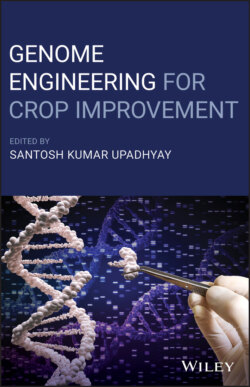Читать книгу Genome Engineering for Crop Improvement - Группа авторов - Страница 57
3.5 Regulatory Measures for Genome Engineering Crops
ОглавлениеThe classical breeding methods largely depend on selection and crossing to develop homologous recombinant. These techniques are utilized from decades ago to make selection of novel traits and introgression into elite cultivars to obtain desirable phenotype. The traditional breeding methods have helped to develop many improved cultivars in several crops important for food security, however, it requires much time and successive generations for selection (Chahal and Gosal 2002). Moreover, the unavailability of genetic variability in major crops have further hindered the classical breeding approach (Pacher and Puchta 2017). The modern breeding technologies have potential to overcome these challenges and are successfully utilized to a variety of crops. Mutation breeding for the development of transgenic and non‐transgenic plants are worthy strategies utilized for crop improvement programs (Scheben et al. 2017). The traditional mutagenesis approaches have helped to develop genetic variations in traits of interest to improve yield and quality. However, the traditional mutagenesis approaches require, labor oriented screening of a large number of mutant population (Sikora et al. 2011), less precise and leaves breeding programs, that unable to meet the requirements (Scheben et al. 2017). The transgenic breeding efforts have been utilized to introduce important genes in cultivars with promising attributes. The transgenic breeding approach has potential to overcome crossing barriers to enhance genetic variability. The major concern with transgenic approaches is the public concern regarding the impact on human health and the environment, therefore, commercialization of genetically modified crops (GMOs) is under strict scrutiny (Hartung and Schiemann 2014). In European countries, the GM crops are still not allowed for commercial purposes and are prohibited in the consumer market along with, the GE non‐transgenic crops also going through strict regulatory measures. The new breeding techniques, i.e. ZFNs, TALENs, and CRISPR do not fall under the category of GMOs due to no residues of foreign particles being in targeted genome. The US Department of Agriculture had exempted CRISPR edit crops from GMOs and are allowed to be cultivated and sold to consumers (Waltz 2018). The CRISPR technique will help to reduce the cost required for field trail and data collection of GMOs along with overcoming public concerns. However, there is an urgent need for intensive uniform of regulatory policy for GE tools around the globe.
